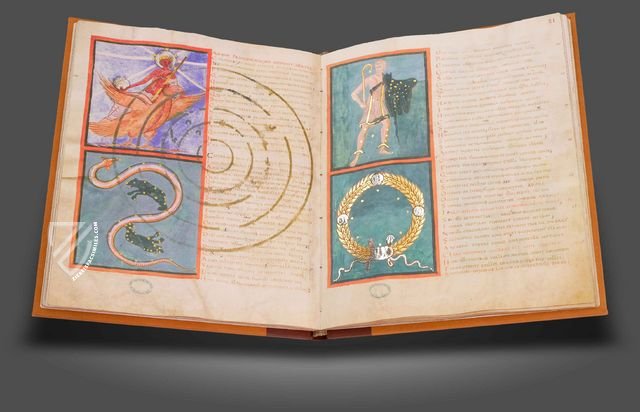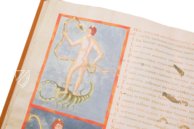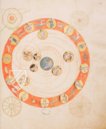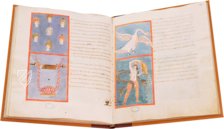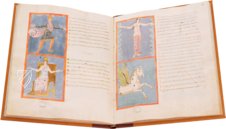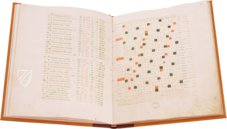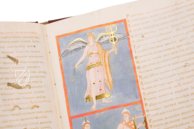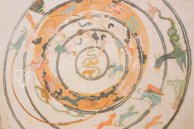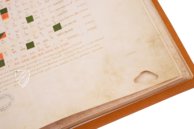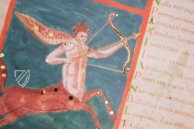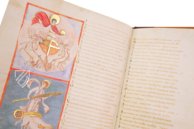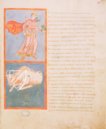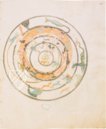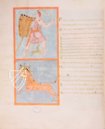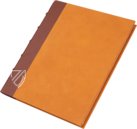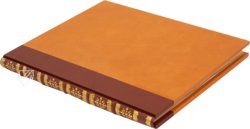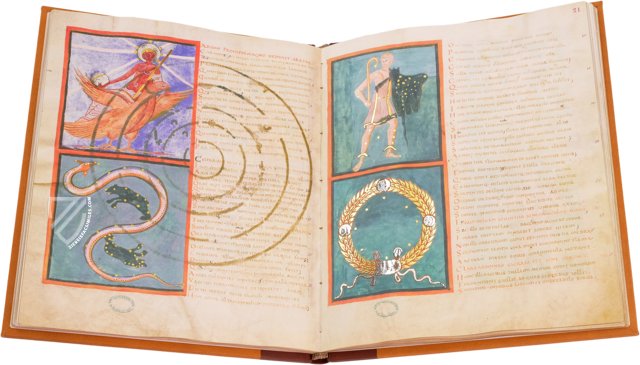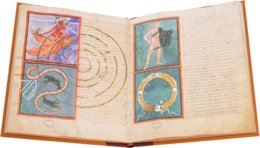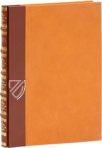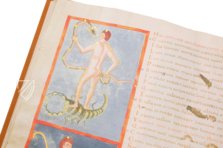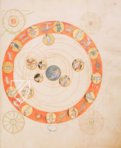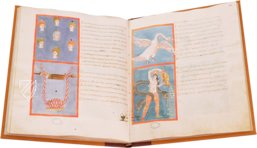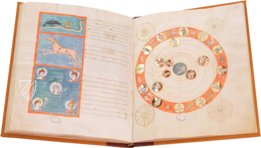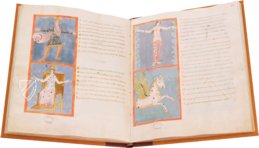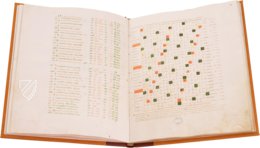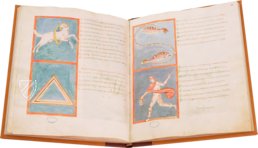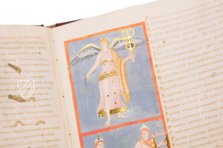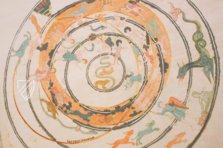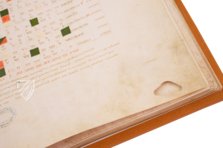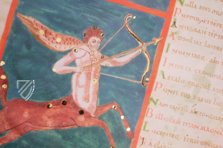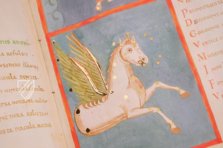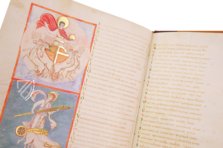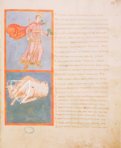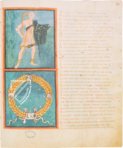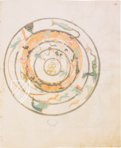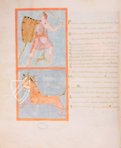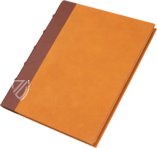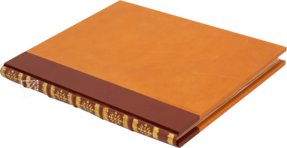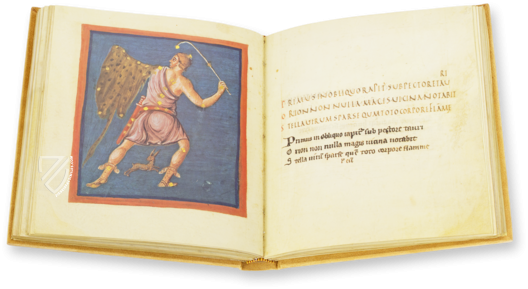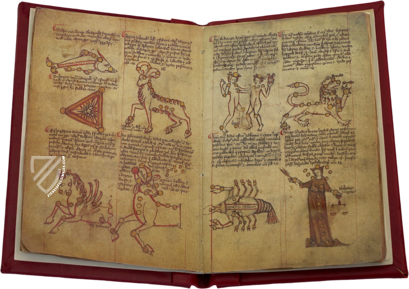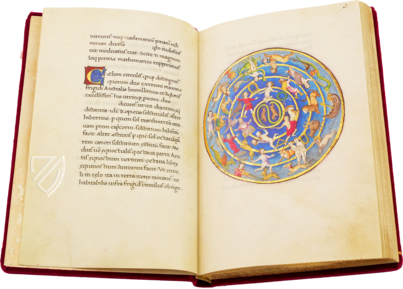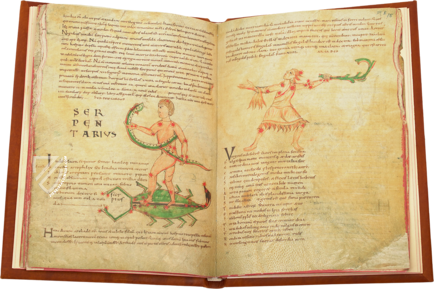Boulogne-sur-Mer Aratea
Publisher's price (new) 2,780 €
With its elaborate, gold-decorated astronomical illuminations, the Boulogne-sur-Mer Aratea is a true gem of Carolingian book art. Created in the Northern French Benedictine Abbey of Saint-Bertin during the 10th century on the basis of the famous Leiden Aratea, this ornate manuscript contains a calendar, a comprehensive computistic treatise, and a special version of the Latin Germanicus translation of the widely received astrological treatise Phainomena by Aratos of Soloi (c. 315–240 BC). This ancient classic is accompanied by two fascinating full-page diagrams of the celestial sphere and the planets, as well as 40 luminous miniatures of constellations and personifications, adorned with precious gold details. They are remarkably close to the original iconography of Late Antiquity and inspired further copies.
Boulogne-sur-Mer Aratea
The Aratea from the Bibliothèque municipale in Boulogne-sur-Mer is without question one of the finest astrological manuscripts from the Carolingian period. It seems to descend from the somewhat better known Leiden Aratea and was itself the inspiration for another Aratea manuscript, now kept in the Burgerbibliothek in Bern, which also originated in the Benedictine Abbey of Saint-Bertin in northern France, a medieval center of book art. There, the Boulogne-sur-Mer Aratea was created sometime after 905 AD, with characteristics of the script and style of illuminations pointing to the period under Abbot Odbert (986–1008).
An Ancient Classic in the Latin Middle Ages.
The Greek Stoic Aratos of Soloi combined complex astronomical mathematics with vivid mythological stories in his Phainomena, written around 370 BC. This probably explains the popularity the work enjoyed in antiquity and throughout the Middle Ages after being rediscovered during the Carolingian Renaissance. Accordingly, the ancient Greek text was translated and adapted several times, for example by Germanicus in the 1st century AD and Avienus in the middle of the 4th century AD. The Boulogne-sur-Mer Aratea contains a special version of the Germanicus translation, into which individual passages by Avienus were integrated. In this manuscript, the astrological treatise follows a calendar and a comprehensive computistical text used to calculate the date of Easter.
Greek Constellations in Splendid Colors and Gold
The Latin translation is accompanied by gorgeous miniatures in bright colors that mainly show constellations and are very close to the original iconography of late antiquity. The respective part of the astrological treatise has been executed in two columns, with the left column occupied by two red-framed constellation miniatures each, whose aesthetics are defined by their monochrome, radiant-blue background. The text in the right column was executed in a neat Capitalis Rustica with red-green initials. Two full-page diagrams provide the frame for this ornate main part of the manuscript, showing the famous planisphere and a planetary diagram. The final part of the treatise has been illuminated with the personifications of Sol, Sun, and Luna, Moon. Thereby subtle and at the same time splendid gold applications pervade all miniatures and make the codex a precious gem of Carolingian art.
Codicology
- Alternative Titles
- Aratea von Boulogne-sur-Mer
- Size / Format
- 66 pages / 36.0 × 28.0 cm
- Origin
- France
- Date
- 10th century
- Epochs
- Style
- Genre
- Language
- Script
- Carolingian minuscule, uncial, Capitalis rustica
- Illustrations
- 42 miniatures and diagrams
- Content
- Calendar, computistical treatise, Germanicus Aratea
Boulogne-sur-Mer Aratea
Auriga
The constellation Auriga, engl. charioteer, is shown here in a splendid robe with gold bands. According to the description of the text he holds a gold stick in his right hand. However, instead of extending his left hand to steer the cart, he holds in it two tiny green billy goats, complemented by another one on his shoulder. This iconographic tradition goes back to earlier ancient depictions that show the constellation as a shepherd with a goat over his shoulder. The name of the constellation's main star also goes back to this origin: Capella, meaning "kid".
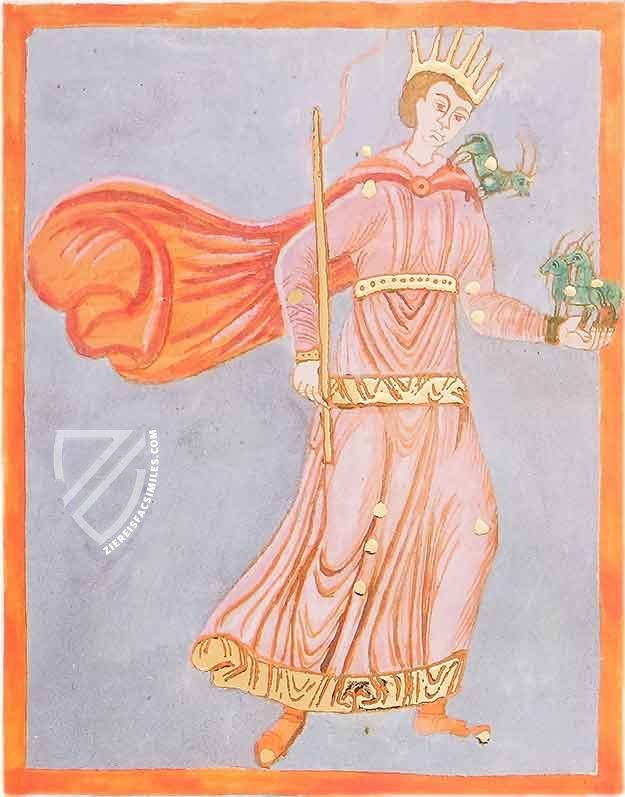
Boulogne-sur-Mer Aratea
Planetary diagram
The wonderful miniatures of the constellations are followed by this elaborate full-page diagram showing the planets as personifications in medallions of different sizes on their orbits. In keeping with the geocentric worldview of the time, the Earth (Terra) is shown in the center: Her personification lies casually on stony ground against a gray-blue background. While Luna moves around the Earth with two pink cows, Venus and Mercury orbit Sol, who rides two horses in a red cloak. Further out are Mars wearing a red cloak and hat, Jupiter riding an eagle, and Saturn in a blue toga.
Framing this depiction is a wide, orange ring that alternately shows the zodiacal signs and the personifications of the months. The latter, like the planets, appear against a luminous gold background that makes the illumination particularly magnificent.

#1 Boulogne-sur-Mer Aratea
Language: Spanish
Publisher's price (new) 2,780 €
- Treatises / Secular Books
- Apocalypses / Beatus
- Astronomy / Astrology
- Bestiaries
- Bibles / Gospels
- Chronicles / History / Law
- Geography / Maps
- Saints' Lives
- Islam / Oriental
- Judaism / Hebrew
- Single Leaf Collections
- Leonardo da Vinci
- Literature / Poetry
- Liturgical Manuscripts
- Medicine / Botany / Alchemy
- Music
- Mythology / Prophecies
- Psalters
- Other Religious Books
- Games / Hunting
- Private Devotion Books
- Other Genres
- Afghanistan
- Armenia
- Austria
- Belgium
- Colombia
- Croatia
- Czech Republic
- Denmark
- Egypt
- Ethiopia
- France
- Germany
- Hungary
- India
- Iran
- Iraq
- Israel
- Italy
- Japan
- Luxembourg
- Mexico
- Morocco
- Netherlands
- Peru
- Poland
- Portugal
- Russia
- Serbia
- Spain
- Sri Lanka
- Sweden
- Switzerland
- Syria
- Turkey
- Ukraine
- United Kingdom
- United States
- Uzbekistan
- Aboca Museum
- Ajuntament de Valencia
- Akademie Verlag
- Akademische Druck- u. Verlagsanstalt (ADEVA)
- Aldo Ausilio Editore - Bottega d’Erasmo
- Alecto Historical Editions
- Alkuin Verlag
- Almqvist & Wiksell
- Amilcare Pizzi
- Andreas & Andreas Verlagsbuchhandlung
- Archa 90
- Archiv Verlag
- Archivi Edizioni
- Arnold Verlag
- ARS
- Ars Magna
- ArtCodex
- AyN Ediciones
- Azimuth Editions
- Badenia Verlag
- Bärenreiter-Verlag
- Belser Verlag
- Belser Verlag / WK Wertkontor
- Benziger Verlag
- Bernardinum Wydawnictwo
- BiblioGemma
- Biblioteca Apostolica Vaticana (Vaticanstadt, Vaticanstadt)
- Bibliotheca Palatina Faksimile Verlag
- Bibliotheca Rara
- Boydell & Brewer
- Bramante Edizioni
- Brepols Publishers
- British Library
- C. Weckesser
- Caixa Catalunya
- Canesi
- CAPSA, Ars Scriptoria
- Caratzas Brothers, Publishers
- Carus Verlag
- Circulo Cientifico
- Club Bibliófilo Versol
- Club du Livre
- CM Editores
- Collegium Graphicum
- Collezione Apocrifa Da Vinci
- Comissão Nacional para as Comemorações dos Descobrimentos Portugueses
- Coron Verlag
- Corvina
- CTHS
- D. S. Brewer
- De Agostini/UTET
- De Schutter
- Deuschle & Stemmle
- Deutscher Verlag für Kunstwissenschaft
- DIAMM
- Droz
- E. Schreiber Graphische Kunstanstalten
- Ediciones Boreal
- Ediciones Grial
- Ediclube
- Edições Inapa
- Edilan
- Editalia
- Edition Georg Popp
- Edition Leipzig
- Edition Libri Illustri
- Editiones Reales Sitios S. L.
- Éditions de l'Oiseau Lyre
- Editions Medicina Rara
- Editorial Casariego
- Editorial Mintzoa
- Editrice Antenore
- Editrice Velar
- Edizioni Edison
- Egeria, S.L.
- Eikon Editores
- Electa
- Enciclopèdia Catalana
- Eos-Verlag
- Ephesus Publishing
- Eugrammia Press
- Extraordinary Editions
- Fackelverlag
- Facsimila Art & Edition
- Facsimile Editions Ltd.
- Facsimilia Art & Edition Ebert KG
- Faksimile Verlag
- Feuermann Verlag
- Folger Shakespeare Library
- Franco Cosimo Panini Editore
- Friedrich Wittig Verlag
- Fundación Hullera Vasco-Leonesa
- G. Braziller
- Gabriele Mazzotta Editore
- Gebr. Mann Verlag
- Gesellschaft für graphische Industrie
- Getty Research Institute
- Giovanni Domenico de Rossi
- Giunti Editore
- Graffiti
- Grafica European Center of Fine Arts
- Guido Pressler
- Guillermo Blazquez
- H. N. Abrams
- Harrassowitz
- Helikon
- Hendrickson Publishers
- Henning Oppermann
- Herder Verlag
- Hes & De Graaf Publishers
- Hoepli
- Hortus Deliciarum
- Houghton Library
- Hugo Schmidt Verlag
- Idion Verlag
- Il Bulino, edizioni d'arte
- ILte
- Imago
- Insel Verlag
- Instituto de Estudios Altoaragoneses
- Instituto Nacional de Antropología e Historia
- Istituto dell'Enciclopedia Italiana - Treccani
- Istituto Ellenico di Studi Bizantini e Postbizantini
- Istituto Geografico De Agostini
- Istituto Poligrafico e Zecca dello Stato
- Italarte Art Establishments
- J. Thorbecke
- Jan Thorbecke Verlag
- Johnson Reprint Corporation
- Jugoslavija
- Karl W. Hiersemann
- Kasper Straube
- Kaydeda Ediciones
- Konrad Kölbl Verlag
- Kurt Wolff Verlag
- La Liberia dello Stato
- La Linea Editrice
- La Meta Editore
- Lambert Schneider
- Landeskreditbank Baden-Württemberg
- Leo S. Olschki
- Les Incunables
- Library of Congress
- Libreria Musicale Italiana
- Lichtdruck
- Lito Immagine Editore
- Lumen Artis
- Lund Humphries
- M. Moleiro Editor
- Maison des Sciences de l'homme et de la société de Poitiers
- Manuscriptum
- Maruzen-Yushodo Co. Ltd.
- MASA
- McGraw-Hill
- Militos
- Millennium Liber
- Müller & Schindler
- National Library of Wales
- Neri Pozza
- Nova Charta
- Oceanum Verlag
- Odeon
- Orbis Mediaevalis
- Orbis Pictus
- Österreichische Staatsdruckerei
- Oxford University Press
- Pageant Books
- Parzellers Buchverlag
- Patrimonio Ediciones
- Pattloch Verlag
- PIAF
- Pieper Verlag
- Plon-Nourrit et cie
- Prestel Verlag
- Princeton University Press
- Prisma Verlag
- Priuli & Verlucca, editori
- Pro Sport Verlag
- Propyläen Verlag
- Pytheas Books
- Quaternio Verlag Luzern
- Reales Sitios
- Recht-Verlag
- Reichert Verlag
- Reichsdruckerei
- Riehn & Reusch
- Roberto Vattori Editore
- Rosenkilde and Bagger
- Roxburghe Club
- Salerno Editrice
- Sarajevo Svjetlost
- Schöck ArtPrint Kft.
- Scolar Press
- Scrinium
- Scripta Maneant
- Scriptorium
- Siloé, arte y bibliofilia
- SISMEL - Edizioni del Galluzzo
- Sociedad Mexicana de Antropología
- Sorli Ediciones
- Stainer and Bell
- Styria Verlag
- Sumptibus Pragopress
- Szegedi Tudomànyegyetem
- Taberna Libraria
- Tarshish Books
- Taschen
- Tempus Libri
- Testimonio Compañía Editorial
- Thames and Hudson
- The Clear Vue Publishing Partnership Limited
- The Facsimile Codex
- The Folio Society
- The Marquess of Normanby
- The Richard III and Yorkist History Trust
- Tip.Le.Co
- TouchArt
- TREC Publishing House
- TRI Publishing Co.
- Trident Editore
- Typis Regiae Officinae Polygraphicae
- Universidad de Granada
- University of California Press
- University of Chicago Press
- Urs Graf
- Vallecchi
- Van Wijnen
- VCH, Acta Humaniora
- VDI Verlag
- Verlag für Regionalgeschichte
- Verlag Styria
- Vicent Garcia Editores
- W. Turnowsky
- Wiener Mechitharisten-Congregation (Wien, Österreich)
- Wissenschaftliche Buchgesellschaft
- Xuntanza Editorial
- Zollikofer AG

